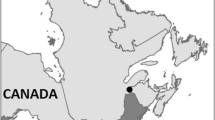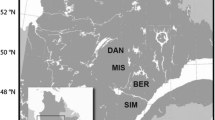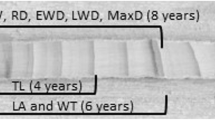Abstract
In the eastern Canadian boreal forest, long fire return intervals lead to over 60% of stands having an irregular, uneven-aged structure, which is associated with slower growth. The aim of this study was to evaluate the effect of stand structure on the dimensional stability of black spruce wood [Picea mariana (Mill.) B.S.P.]. Sixty trees were sampled from stands with regular and irregular structures from the North Shore region of Quebec, Canada. Nonlinear mixed-effect models were developed for each stand structure to describe the variation in two indicators of dimensional stability, the differential volumetric shrinkage ratio (GV) and the dimensional hygroexpansion coefficient (R-ratio), in small defect-free wood samples as functions of cambial age and annual ring width. GV and R-ratio were strongly related to cambial age, but there was a limited effect of ring width. After accounting for these variables, samples from stands of irregular structure had greater dimensional stability than those from stands with a regular structure, although GV and R-ratio differences were more pronounced in the upper stem compared with breast height. The fixed effects of the models explained between 44 and 60% of the variation in GV, and between 7 and 44% of the variation in R-ratio. A higher presence of mild reaction wood or lower within-ring variation in wood density in trees of layer origin from irregular stands may explain the observed differences between stand structures.





Similar content being viewed by others
References
Alteyrac J, Cloutier A, Ung C-H, Zhang SY (2006) Mechanical properties in relation to selected wood characteristics of black spruce. Wood Fiber Sci 38:229–237
Antal M, Micko MM (1994) Variation and field estimation of wood quality parameters for black spruce. Holzforsch Holzverw 46:70–72
Arévalo R, Hernández RE (2001) Influence of moisture sorption on swelling of mahogany (Swietenia macrophylla King) wood. Holzforschung 55:590–594
Aubry CA, Adams W, Thomas DF (1998) Determination of relative economic weights for multitrait selection in coastal Douglas-fir. Can J For Res 28:1164–1170
Auty D, Gardiner BA, Achim A, Moore JR, Cameron AD (2013) Models for predicting microfibril angle variation in Scots pine. Ann For Sci 70:209–218
Baayen RH, Davidson DJ, Bates DM (2008) Mixed-effects modeling with crossed random effects for subjects and items. J Mem Lang 59:390–412
Bannan MW (1965) The length, tangential diameter, and length/width ratio of conifer tracheids. Can J Bot 43:967–984
Barrette J, Pothier D, Ward C (2013) Temporal changes in stem decay and dead and sound wood volumes in the northeastern Canadian boreal forest. Can J for Res 43:234–244
Beaudoin M, Masanga BO, Poliquin J, Beauregard RL (1989) Physical and mechanical properties of plantation grown tamarack. Forest Prod J 39:5–10
Benjamin JG, Kershaw JA, Weiskittel AR, Chui YH, Zhang SY (2009) External knot size and frequency in black spruce trees from an initial spacing trial in Thunder Bay, Ontario. For Chron 85:618–624
Bergeron Y, Gauthier S, Kafka V, Lefort P, Lesieur D (2001) Natural fire frequency for the eastern Canadian boreal forest: consequences for sustainable forestry. Can J For Res 31:384–391
Bolker B (2020) Getting started with the glmmTMB package. R version 3.6.3 (2020–02–29) and package versions: 1.0.23.1 (bbmle) 1.0.1 (glmmTMB). https://cran.r-project.org/web/packages/glmmTMB/vignettes/glmmTMB.pdf. Accessed 25 Jul 2020
Bouchard M, Pothier D, Gauthier S (2008) Fire return intervals and tree species succession in the North Shore region of Eastern Quebec. Can J for Res 38:1621–1633
Brooks ME, Kristensen K, van Benthem KJ, Magnusson A, Berg CW, Nielsen A, Skaug HJ, Maechler M, Bolker BM (2017) glmmTMB balances speed and flexibility among packages for zero-inflated generalized linear mixed modeling. R Journal 9:378–400
Bustos C, Beauregard R, Mohammad M, Hernández RE (2003) Structural performance of finger-jointed black spruce lumber with different joint configuration. Forest Prod J 53:72–76
Natural Resources Canada (NRCan) (2018) The state of Canada’s forests: annual report 2018. Canadian Forest Service, Ottawa
Chabot M, Blanchet P, Drapeau P, Fortin J, Gauthier S, Imbeau L, Lacasse G, Lemaire G, Nappi A, Quenneville R, Thiffault É (2009) Le feu en milieu forestier (Fire in a forest environment). In: Ordre des ingénieurs forestiers du Québec. Manuel de Foresterie, 2eéd. Ouvrage collectif. Éditions MultiMondes. Québec, pp 1037–1090 (in French)
Chafe SC (1986) Collapse, volumetric shrinkage, specific gravity and extractives in eucalyptus and other species. Part 1: The shrinkage/specific gravity ratio. Wood Sci Technol 20:293–307
Chafe SC (1987) Collapse, volumetric shrinkage, specific gravity and extractives in eucalyptus and other species. Part 2: The influence of wood extractives. Wood Sci Technol 21:27–41
Chau T, Ma E, Cao J (2015) Moisture adsorption and hygroexpansion of paraffin wax emulsion-treated Southern pine (Pinus spp.). BioResources 10:2719–2731
Cyr D, Gauthier S, Bergeron Y (2007) Scale-dependent determinants of heterogeneity in fire frequency in a coniferous boreal forest of eastern Canada. Landscape Ecol 22:1325–1339
Donaldson LA, Grace J, Downes GM (2004) Within-tree variation in anatomical properties of compression wood in radiata pine. IAWA J 25:253–271
Dumail JF, Castera P (1997) Transverse shrinkage in maritime pine juvenile wood. Wood Sci Technol 31:251–264
Dutilleul P, Herman M, Avella-Shaw T (1998) Growth rate effects on correlations among ring width, wood density, and mean tracheid length in Norway spruce (Picea abies). Can J for Res 28:56–68
Fernández Golfín JI, Diez MR (1994) Influencia de la anchura del anillo de crecimiento en la densidad y otras propiedades físico-mecánicas de la madera estructural de diversas especies (Influence of the growth ring width on the density and other physico-mechanical properties of structural wood of various species). Investigación Agraria Sistemas y Recursos Forestales 3:211–219 ((in Spanish))
Foulger AN (1966) Longitudinal shrinkage pattern in eastern white pine stems. For Prod J 16:45–47
Garcia RA, Rosero-Alvarado J, Hernández RE (2020) Full-field moisture-induced strains of the different tissues of tamarack and red oak woods assessed by 3D digital image correlation. Wood Sci Technol 54:139–159
Gardiner BA, Marshall B, Achim A, Belcher R, Wood C (2005) The stability of different silvicultural systems: a wind-tunnel investigation. Forestry 78:471–484
Gomez Loranca JA, Gutierrez Oliva A, Baonza Merino MV (1996) Influencia de la intensidad de clara en el crecimiento, la producción y las características de la madera en una masa artificial de Pinus sylvestris L (Influence of thinning intensity on wood growth, production and characteristics on an artificial mass of Pinus sylvestris L). Investigación Agraria Sistemas y Recursos Forestales 5:257–273 ((in Spanish))
Gryc V, Vavrčík H, Horáček P (2007) Variability in swelling of spruce (Picea abies [L.] Karst.) wood with the presence of compression wood. J For Sci 57:243–252
Hassegawa M, Savard M, Lenz PRN, Duchateau E, Gélinas N, Bousquet J, Achim A (2020) White spruce wood quality for lumber products: priority traits and their enhancement through tree improvement. Forestry 93:16–37
Hernández RE (2007a) Swelling properties of hardwoods as affected by their extraneous substances, wood density, and interlocked grain. Wood Fiber Sci 39:146–158
Hernández RE (2007b) Moisture sorption properties of hardwoods as affected by their extraneous substances, wood density, and interlocked grain. Wood Fiber Sci 39:132–145
Huang S, Meng SX, Yang Y (2009) Assessing the goodness-of-fit of forest models estimated by nonlinear mixed model methods. Can J for Res 39:2418–2436
Jessome AP (2000) Strength and related properties of woods grown in Canada. SP 514-E, Forintek Canada Corp Québec
Kärkkäinen M, Marcus M (1985) Shrinkage properties of Norway spruce wood. Silva Fenn 19:67–72
Keith CT (1986) An exploratory study of the properties of fast-grown jack pine and European larch in eastern Canada. Internal report. Wood Sci. Department. Forintek Canada Corp
Kelsey KE (1956) The shrinkage intersection point. Its significance and the method of its determination. Forest Prod J 6:411–416
Koubaa A, Hernández RE, Beaudoin M (1998) Shrinkage of fast-growing poplar hybrid clones. Forest Prod J 48:82–87
Koubaa A, Zhang SYT, Makni S (2002) Defining the transition from earlywood to latewood in black spruce based on intra-ring wood density profiles from X-ray densitometry. Ann for Sci 59:519–524
Krzemién L, Strojecki M, Wroński S, Tarasiuk J, Łukomski M (2015) Dynamic response of earlywood and latewood within annual growth ring structure of Scots pine subjected to changing relative humidity. Holzforschung 69:555–556
Kuprevicius A, Auty D, Achim A, Caspersen JP (2013) Quantifying the influence of live crown ratio on the mechanical properties of clear wood. Forestry 86:361–369
Larson PR, Kretschmann DE, Clark AIII, Isebrands JG (2001) Formation and properties of juvenile wood in southern pines: a synopsis. Gen. Tech. Rep. FPL-GTR-129. USDA. Forest Products Laboratory. Madison, WI
Leban J-M, Haines DW (1999) The modulus of elasticity of hybrid larch predicted by density, rings per centimetre and age. Wood Fiber Sci 31:394–402
Lei YC, Zhang SY, Jiang Z (2005) Models for predicting lumber bending MOR and MOE based on tree and stand characteristics in black spruce. Wood Sci Technol 39:37–47
Lemay A, Krause C, Achim A, Bégin J (2018) Growth and wood quality of black spruce and balsam fir following careful logging around small merchantable stems (CLASS) in the boreal forest of Quebec, Canada. Forestry 91:271–282
Lexerød NL, Eid T (2006) An evaluation of different diameter diversity indices based on criteria related to forest management planning. For Ecol Manage 222:17–28
Lindstrom MJ, Bates DM (1990) Nonlinear mixed effects models for repeated measures data. Biometrics 46:673–687
Liu C, Zhang SY, Cloutier A, Rycabel T (2007) Modeling lumber bending stiffness and strength in natural black spruce stands using stand and tree characteristics. For Ecol Manage 242:648–655
Macdonald E, Hubert J (2002) A review of the effects of silviculture on timber quality of Sitka spruce. Forestry 75:107–138
Magnusson A, Skaug H, Nielsen A, Berg C, Kristensen K, Maechler M, van Bentham K, Sadat N, Bolker B, Brooks M (2020) Package glmmTMB: generalized linear mixed models using template model builder. R Package Version 1:1
Mencuccini M, Grace J, Fioravanti M (1997) Biomechanical and hydraulic determinants of tree structure in Scots Pine: anatomical characteristics. Tree Physiol 17:105–113
Noack D, Schwab E, Bartz A (1973) Characteristics for a judgment of the sorption and swelling behavior of wood. Wood Sci Technol 7:218–236
Pamerleau-Couture É, Rossi S, Pothier D, Krause C (2019) Wood properties of black spruce (Picea mariana (Mill.) BSP) in relation to ring width and tree height in even- and uneven-aged boreal stands. Ann For Sci 76:43
Paradis N, Auty D, Carter P, Achim A (2013) Using a standing-tree acoustic tool to identify forest stands for the production of mechanically graded lumber. Sensors 13:3394–3408
Parresol BR (1999) Assessing tree and stand biomass: a review with examples and critical comparisons. For Sci 45:573–593
Pinheiro JC, Bates DM (2000) Mixed-effects models in S and S-PLUS. Statistics and computing series. Springer-Verlag, New York, NY
Pinheiro JC, Bates DM, DebRoy S, Sarkar D, R Core Team (2020) nlme: linear and nonlinear mixed effects models. R package version 3.1–148. https://CRAN.R-project.org/package=nlme. Accessed 10 Aug 2020
Pothier D, Margolis HA, Poliquin J, Waring RH (1989) Relation between the permeability and the anatomy of jack pine sapwood with stand development. Can J for Res 19:1564–1570
R Core Team (2020) R: A language and environment for statistical computing. R Foundation for Statistical Computing, Vienna
Raulier F, Leduc A, Roy R, Vaillancourt M-A (2009) Aménagement de la forêt (Forest management). In: Ordre des ingénieurs forestiers du Québec. Manuel de Foresterie, 2eéd. Ouvrage collectif. Éditions MultiMondes. Québec, pp 649–676 (in French)
Ross RJ (2010) Wood handbook - Wood as an engineering material. Centennial ed. General technical report FPL-GTR-190. Madison, WI: U.S. Department of Agriculture, Forest Service, Forest Products Laboratory
Schmidt EL, Riggio M, Barbosa AR, Mugabo I (2019) Environmental response of a CLT floor panel: lessons for moisture management and monitoring of mass timber buildings. Build Environ 148:609–622
Skaar C (1988) Wood-water relations. Springer, Berlin
Stacey GR, Belcher RE, Wood CJ, Gardiner BA (1994) Wind and wind forces in a model spruce forest. Bound Layer Meteorol 69:311–334
Stanek W (1961) Natural layering of black spruce in northern Ontario. Forest Chron 37:245–258
Stanek W (1968) Development of black spruce layers in Quebec and Ontario. Forest Chron 44:25–28
Timell TE (1986) Compression wood in gymnosperms. Springer, Berlin
Torquato LP, Auty D, Hernández RE, Duchesne I, Pothier D, Achim A (2014) Black spruce trees from fire-origin stands have higher wood mechanical properties than those from older, irregular stands. Can J for Res 44:118–127
Waldron K, Auty D, Tong T, Ward C, Pothier D, Torquato LP, Achim A (2020) Fire as a driver of wood mechanical traits in the boreal forest. For Ecol Manage. https://doi.org/10.1016/j.foreco.2020.118460
Ward C, Pothier D, Paré D (2014) Do boreal forests need fire disturbance to maintain productivity? Ecosystems 17:1053–1067
Warensjö M, Rune G (2004) Stem straightness and compression wood in a 22-year-old stand on container-grown Scots pine trees. Silva Fenn 38:143–153
Wilhelmsson L, Arlinger J, Spangberg K, Lundqvist S, Grahn T, Hedenberg O, Olsson L (2002) Models for predicting wood properties in stems of Picea abies and Pinus sylvestris in Sweden. Scand J Res 17:330–350
Yamashita K, Hirakawa Y, Nakatani H, Ikeda M (2009) Tangential and radial shrinkage variation within trees in sugi (Cryptomeria japonica) cultivars. J Wood Sci 55:161–168
Yang T, Ma E (2015) Dynamic sorption and hygroexpansion of wood subjected to cyclic relative humidity changes II effect of temperature. Bioresources 10:1675–1685
Yao J (1969) Shrinkage properties of second-growth southern yellow pine. Wood Sci Technol 3:25–39
Zhang SY (1995) Effect of growth rate on wood specific gravity and selected mechanical properties in individual species from distinct wood categories. Wood Sci Technol 29:451–465
Zhang SY, Koubaa A (2008) Softwoods of Eastern Canada: Their silvics, characteristics, manufacturing and end-uses. FPInnovations, Quebec
Zhang SY, Chauret G, Ren H, Desjardins R (2002) Impact of initial spacing on plantation black spruce lumber grade yield, bending properties, and MSR yield. Wood Fiber Sci 34:460–475
Zobel BJ, Jett JB (1995) Genetics of wood production - Springer Series in Wood Science. Springer-Verlag, Berlin
Acknowledgements
The authors also thank Daniel Bourgault, Sylvain Auger, Luc Germain, David Lagueux, Daniel Breton, Jenny McKenzie, Emmanuel Duchateau, Erika Blackburn, Fabien Lanteigne, Louis Gauthier, and Amélie Denoncourt for their valuable assistance on this project.
Funding
Funding for this project was provided by the Natural Sciences and Engineering Research Council of Canada (NSERC) through the ForValueNet Strategic Network on Forest Management for Value-added Products and the NSERC-Université Laval Industrial Research Chair in Silviculture and Wildlife.
Author information
Authors and Affiliations
Contributions
All authors contributed to the writing and revision of the manuscript. All authors read and approved the final manuscript.
Corresponding author
Ethics declarations
Conflict of interest
The authors declare that they have no conflict of interest.
Additional information
Publisher's Note
Springer Nature remains neutral with regard to jurisdictional claims in published maps and institutional affiliations.
Rights and permissions
About this article
Cite this article
Torquato, L.P., Hernández, R.E., Duchesne, I. et al. Black spruce trees from uneven-aged, old-growth stands produce more dimensionally stable wood than trees from fire-origin even-aged stands. Wood Sci Technol 55, 1457–1483 (2021). https://doi.org/10.1007/s00226-021-01314-5
Received:
Accepted:
Published:
Issue Date:
DOI: https://doi.org/10.1007/s00226-021-01314-5




